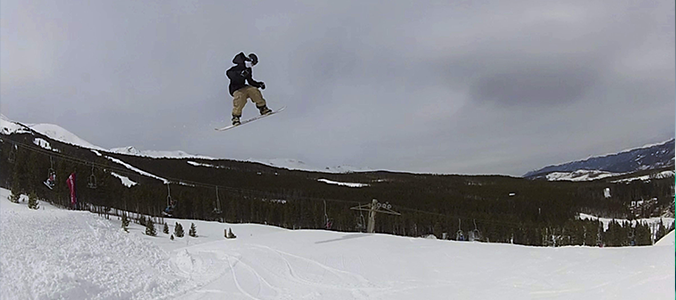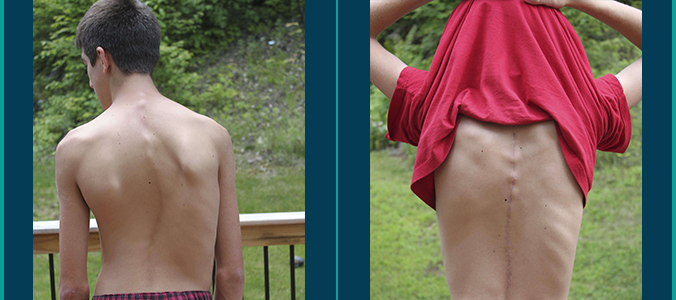Snowboarding After Scoliosis
Sparta, NJ Resident Returns to Snowboarding After Scoliosis Surgery
15-year-old Jared Muller was snowboarding during a family vacation to Vermont when his mother noticed something odd: One of Jared’s shoulder blades was elevated much higher than the other one.
Alarmed by her recent discovery, Jared’s mom began to research medical issues that can cause uneven shoulder blades. When the evidence began to point toward scoliosis, Jared’s mom turned her focus elsewhere. She would need to find the best scoliosis doctor in Sparta, NJ for her son.
It didn’t take long for Jared’s mom to stumble across Dr. Jason E. Lowenstein, MD, Director of Scoliosis & Spinal Deformity Surgery at Morristown Medical Center. Although Muller’s son attended an appointment almost immediately after she placed that first phone call, doctors deemed Jared’s scoliosis severe. At 65-degrees of deviation from the norm, Jared’s spine would require scoliosis surgery to repair.
“Depending on the patient’s age, surgery is recommended if the curve is greater than 40-50 degrees. So when I first met with Jared, he was past the point of brace therapy. I knew surgery was the best option to relieve him of the pain he was in,” explains Dr. Lowenstein.
“As we do for all of our patients, we created an individualized treatment plan to help Jared and used our advanced technology to see real-time CT images during his surgery, ensuring we were guiding our hardware to the right location with pinpoint accuracy.”

Jared’s Recovery from Scoliosis Surgery
Although a resounding success, Jared admits that the recovery period came with its own set of challenges. Jared, an active participant in sports like snowboarding, soccer, and basketball, had to adjust to temporarily sitting on the sidelines.
“I usually play sports or exercise in some capacity every day, so for me, sitting on the couch for the first few months was very frustrating,” he said. However, those few months of rest paid off, and Jared could resume his favorite sports–like snowboarding–that winter.
“Looking back, what I always thought was just pain and soreness from working out and playing sports was actually a sign of something much more serious,” Jared said. “Four years later, I know that scoliosis was the cause of my pain and now when I play sports or do something physical, that pain is gone.”

What is Adolescent Idiopathic Scoliosis?
Adolescent Idiopathic Scoliosis (AIS) occurs when a minor between the ages of 10 and 18 develops a sideways bend in the spine for no apparent reason. In fact, this is what the term idiopathic scoliosis means: without a discernible cause.
Other types of scoliosis, for example, occur in response to a condition or an event. For instance, neuromuscular scoliosis results from a neuromuscular disorder, such as cerebral palsy. Congenital scoliosis refers to a type of scoliosis that an infant is born with for congenital reasons such as improper bone formation in the womb. But, cases of idiopathic scoliosis? These remain by and large a mystery.
Researchers think that uneven bone growth during adolescent growth spurts may be to blame. But, a variety of factors–such as hormone levels and muscular imbalances–may come into play.
However, if your child develops AIS in their high school years, it can be easy to miss (as was the case with Jared Muller). Typically, the district requires the school nurse to perform a scoliosis assessment on elementary to middle-school-age children. But, when AIS is most likely to occur–in high school–these checks have already stopped. Unfortunately, 4% of the pediatric population will go on develop AIS. So, doctors recommend that your child continues to receive regular scoliosis exams long after the school checks have ended.
How Dr. Lowenstein Can Help
The Scoliosis & Spinal Deformity Center at Morristown Medical was founded to deliver the highest standard of surgical care to both adults and pediatric patients with spinal deformities. In addition to scoliosis, the spinal deformity center also treats patients with kyphosis, lordosis, spondylolisthesis, and flatback syndrome–among many other even rarer conditions.
Dr. Lowenstein’s team of care professionals creates customizable treatment plans that address each patient’s lifestyle, deformity pattern, and medical needs. Cutting-edge treatments routinely used by the center include genetic testing to predict curve progression, growth preservation techniques such as growing rods, and more traditional methods including scoliosis bracing and anterior or posterior spinal fusion.
To learn how minimally invasive techniques can change your child’s life, contact Dr. Jason Lowenstein today! His team of spine experts will ensure that your child recovers from scoliosis using the most advanced methods in modern scoliosis care. Help your child get back to doing the things that he or she loves, like snowboarding, today!